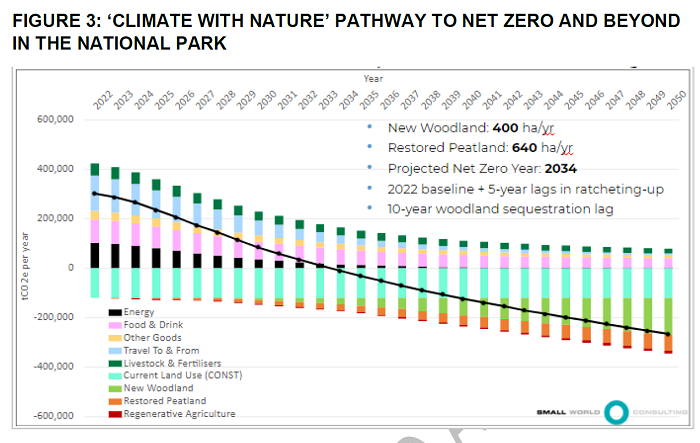On 5th April (see here), in the newsletter they email to land managers, the Loch Lomond and Trossachs National Park Authority (LLTNPA) reported that their National Park Partnership Plan (NPPP) 2024-29 had been approved by Scottish Ministers. There is no mention of this on the “news” section of their website (last item International Women’s Day 8th March) or the section on the NPPP (see here) which still refers to the 2018-23 plan. That may be just as well, since less than two weeks later the NPPP had started to unravel completely.
On 18th April, Mairi McAllan, the Minister responsible for tackling climate change, announced the Scottish Government was dropping its target of reducing 75% of carbon emissions by 2030. A large part of LLTNPA’s NPPP on “climate with nature” was based on the Scottish Government meeting their targets:

No explanation for this graph was given in the draft NPPP. Ronnie Erskine, however, asked at the December LLTNPA meeting how the “ambitious” targets for reducing emissions from energy, food and drink, travel etc shown on the graph above the centre line would be achieved. He was told they were based on the Scottish Government meeting its targets in these areas. With the Scottish Government having abandoned those targets, clearly the LLTNPA’s NPPP is in tatters.
A week later, on 25th April, Humza Yousaf had sacked Lorna Slater, the Green MSP who had had responsibility for National Parks and approved the LLTNPA’s NPPP.
The question now is whether the LLTNPA Board will take the opportunity to scrap the NPPP, which I argued in December is a fundamentally useless document (see here), and have the courage to start again?
A secondary reason for doing so is that the LLTNPA’s targets for woodland expansion and peatland restoration, which were intended to help offset both the Park’s and Scotland’s carbon emissions, were based on the assumption that the Scottish Government would fund these activities. Just a week after the draft NPPP was approved by the LLTNPA Board in December, the Scottish Government announced it was slashing the Scottish Forestry grants budget by £32m or 41%. That meant the LLTNPA’s target of doubling woodland expansion from 200 to 400 hectare a year was effectively unachievable given the level of overgrazing in the National Park and the lack of natural regeneration of woodland.
As the climate change crisis intensifies, therefore, what we don’t need is another Park Plan based on meaningless repetition of targets, which bear no resemblance to reality, or which is entirely dependant on Scottish Government funding. Instead we need action. Whatever the current financial challenges, the LLTNPA could do a lot more to make maximum use of its powers. For example, the NPPP contained this “measurement of success” on carbon emissions:
“Monitor rural transport provision. Reduce transport emissions from travel to and from the National Park by at least 61% from the 2019 baseline by 2030”
The first sentence illustrates the uselessness of the NPPP, monitoring but no action. The second, however, needs to be given bite. A good place to start would be for the LLTNPA to reject the proposed Flamingo Land development which is designed to attract new visitors to the National Park by car (see here).
The dilemma facing Scotland’s two National Parks at present is they have been almost completely beholden to the Scottish Government and the position of the new government is unclear.
My criticism of Lorna Slater’s tenure as Minister responsible for National Parks is not that she did not see their potential for leading the way on tackling climate change and nature, she did. The failure of the Greens in government in respect to National Parks is that they did very little to reform them or make them fit for purpose, as exemplified by Lorna Slater’s approval of the meaningless NPPP. Much of that was probably not her fault but a reflection of the power of other Ministers, who held most of the crucial budgets (rural grants, transports etc) and the cloying role of the civil service.
While there is now an opportunity for the new Scottish Government to start afresh and shift the focus from meaningless policy to practical actions, whether they will do so is another matter. For example, while it appears likely the Scottish Government will shelve the commitment (made under the Bute House agreement) to create a new National Park, there is nothing to suggest they will announce a formal review of Scotland’s two existing National Parks to assess what they have achieved and what reforms are necessary. That is the first step that needs to happen if they are to contribute meaningfully to tackling the nature and climate crises while delivering for people..
Unfortunately, what public pressure there is at present is to scrap plans for a new National Park – a consequence of the Scottish Government’s botched consultation process (see here) – rather than reforming how they are run and giving them new powers which would make it easier for them to make a difference.

1 Comment on “Carbon emissions targets and the Lomond & Trossachs National Park Plan – time for a re-set”